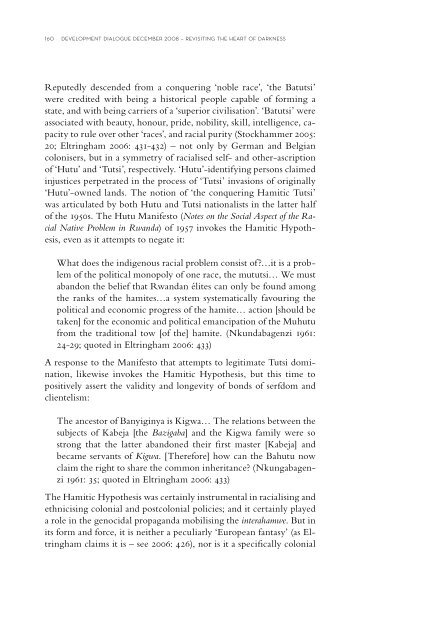60 years after the UN Convention - Dag Hammarskjöld Foundation
60 years after the UN Convention - Dag Hammarskjöld Foundation
60 years after the UN Convention - Dag Hammarskjöld Foundation
You also want an ePaper? Increase the reach of your titles
YUMPU automatically turns print PDFs into web optimized ePapers that Google loves.
1<strong>60</strong> development dialogue december 2008 – revisiting <strong>the</strong> heart of darkness<br />
Reputedly descended from a conquering ‘noble race’, ‘<strong>the</strong> Batutsi’<br />
were credited with being a historical people capable of forming a<br />
state, and with being carriers of a ‘superior civilisation’. ‘Batutsi’ were<br />
associated with beauty, honour, pride, nobility, skill, intelligence, capacity<br />
to rule over o<strong>the</strong>r ‘races’, and racial purity (Stockhammer 2005:<br />
20; Eltringham 2006: 431-432) – not only by German and Belgian<br />
colonisers, but in a symmetry of racialised self- and o<strong>the</strong>r-ascription<br />
of ‘Hutu’ and ‘Tutsi’, respectively. ‘Hutu’-identifying persons claimed<br />
injustices perpetrated in <strong>the</strong> process of ‘Tutsi’ invasions of originally<br />
‘Hutu’-owned lands. The notion of ‘<strong>the</strong> conquering Hamitic Tutsi’<br />
was articulated by both Hutu and Tutsi nationalists in <strong>the</strong> latter half<br />
of <strong>the</strong> 1950s. The Hutu Manifesto (Notes on <strong>the</strong> Social Aspect of <strong>the</strong> Racial<br />
Native Problem in Rwanda) of 1957 invokes <strong>the</strong> Hamitic Hypo<strong>the</strong>sis,<br />
even as it attempts to negate it:<br />
What does <strong>the</strong> indigenous racial problem consist of?…it is a problem<br />
of <strong>the</strong> political monopoly of one race, <strong>the</strong> mututsi… We must<br />
abandon <strong>the</strong> belief that Rwandan élites can only be found among<br />
<strong>the</strong> ranks of <strong>the</strong> hamites…a system systematically favouring <strong>the</strong><br />
political and economic progress of <strong>the</strong> hamite… action [should be<br />
taken] for <strong>the</strong> economic and political emancipation of <strong>the</strong> Muhutu<br />
from <strong>the</strong> traditional tow [of <strong>the</strong>] hamite. (Nkundabagenzi 1961:<br />
24-29; quoted in Eltringham 2006: 433)<br />
A response to <strong>the</strong> Manifesto that attempts to legitimate Tutsi domination,<br />
likewise invokes <strong>the</strong> Hamitic Hypo<strong>the</strong>sis, but this time to<br />
positively assert <strong>the</strong> validity and longevity of bonds of serfdom and<br />
clientelism:<br />
The ancestor of Banyiginya is Kigwa… The relations between <strong>the</strong><br />
subjects of Kabeja [<strong>the</strong> Bazigaba] and <strong>the</strong> Kigwa family were so<br />
strong that <strong>the</strong> latter abandoned <strong>the</strong>ir fi rst master [Kabeja] and<br />
became servants of Kigwa. [Therefore] how can <strong>the</strong> Bahutu now<br />
claim <strong>the</strong> right to share <strong>the</strong> common inheritance? (Nkungabagenzi<br />
1961: 35; quoted in Eltringham 2006: 433)<br />
The Hamitic Hypo<strong>the</strong>sis was certainly instrumental in racialising and<br />
ethnicising colonial and postcolonial policies; and it certainly played<br />
a role in <strong>the</strong> genocidal propaganda mobilising <strong>the</strong> interahamwe. But in<br />
its form and force, it is nei<strong>the</strong>r a peculiarly ‘European fantasy’ (as Eltringham<br />
claims it is – see 2006: 426), nor is it a specifi cally colonial

















